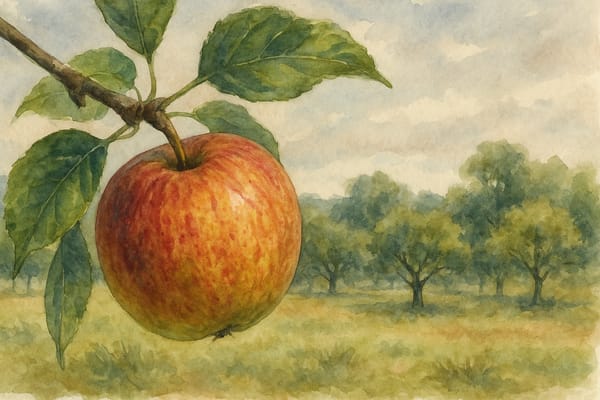There’s something gently romantic about the idea of growing melons in the soft light of a Cornish summer — especially one with a name as evocative as Blenheim Orange. This Victorian heirloom cantaloupe, with its delicate netted skin and fragrant orange flesh, was once favoured by glasshouse growers seeking sweetness and scent in more temperate climes. Today, it still earns its place among the warm borders and greenhouses of keen gardeners across Cornwall.
This variety brings history into your garden — not just in name, but in form. Its fruit is rounded, mid-sized, and richly perfumed when ripe. Beneath the intricately netted surface lies flesh that glows sunset-orange and offers a sweetness that deepens on the vine. And while Cornwall may not seem the most obvious home for melons, this one thrives with a little care and warmth — especially under glass or in a well-sheltered suntrap.
Sowing with Purpose
Begin your melon journey indoors, ideally between late February and April. Blenheim Orange needs heat to germinate, so a propagator or warm windowsill with steady temperatures between 20–21°C (68–70°F) is best. Sow seeds on their sides — it’s a small but important tip that reduces the risk of rot. Nestle them around 1.5cm deep in quality compost, ideally in 9cm pots or modules.
Place the pots in bright, indirect light, keeping them away from strong midday sun. Two seeds per pot is a good rule — then remove the weaker seedling once both have germinated. Expect sprouting within 7 to 14 days.
Raising the Young Plants
As the seedlings emerge, they’ll stretch and settle in. Keep them warm (18–21°C) and never let them sit in soggy compost. Once they’ve established their first true leaves, begin hardening them off gradually — over about two weeks — before moving them to their final home. If you’re growing outdoors, wait until nighttime temperatures are reliably above 12–15°C, and choose the warmest, sunniest corner of your garden.
In Cornwall, a polytunnel or greenhouse will give you the best results. Large containers or growbags work well — two plants per growbag is ideal. Rich, free-draining soil, enriched with compost or well-rotted manure, sets the stage for lush growth.
Training the Vine
Like many heritage melons, Blenheim Orange benefits from traditional training. Pinch out the main growing tip once four or five true leaves have formed — this encourages strong side shoots. Select four laterals to train — allow them to grow, then pinch again after a few leaves to promote fruit-bearing sub-laterals.
Whether you grow your melon vertically up netting or let it ramble freely, keep an eye on airflow and shape. Melons appreciate structure, and supporting their stems helps avoid damage as the fruit begins to swell.
Flowers, Pollination & Fruit Set
In Cornwall’s varied climate, even in summer, hand-pollination is often your best bet — particularly if growing under glass. Look for the tiny swelling behind female flowers and gently transfer pollen from male blooms using a soft brush or fingertip.
Limit the number of fruits: for greenhouse plants, aim for four to six melons; outdoors, two to four is plenty. Fewer fruits mean better ripening and sweeter flavour — especially in cooler or cloudy stretches of the summer.
Feeding and Watering
Blenheim Orange is a thirsty plant, especially when fruit begins to form. Water consistently at the base — avoiding leaves and stems — to reduce the risk of fungal issues. During hotter spells, increase watering frequency, especially if the fruit is swelling.
Once melons reach the size of walnuts, begin weekly feeds with a high-potash fertiliser (like tomato feed). Avoid nitrogen-rich formulas — they promote leafy growth at the expense of fruit.
Mulching around the root zone helps retain moisture and discourage weeds, but keep a clear space around the stem to prevent rot. If growing fruit vertically, support each melon with a soft sling. If trailing on the ground, raise them up onto tiles or dry boards to keep them from contact with the damp soil.
Harvest Time: Fragrance in the Air
The moment of harvest is a sensory one. Ripe Blenheim Orange melons will begin to emit a deep, musky scent — a sign their sugars are fully developed. The skin may take on a golden hue and the fruit will often “slip” easily from the stem.
It’s best to harvest in the morning and enjoy them as soon as possible — chilled or fresh. Stored in the fridge, they’ll last a few days, but the true flavour is at its peak straight from the vine.
Seasonal Magic, Victorian Charm
There’s a quiet joy in growing melons in the South West. Whether tucked into a sheltered garden nook near the coast or trained along strings in a Cornish greenhouse, Blenheim Orange offers more than fruit — it gives you connection: to gardeners of the past, to the warmth of summer days, and to the patient rhythm of sowing, tending, waiting, and reaping.











